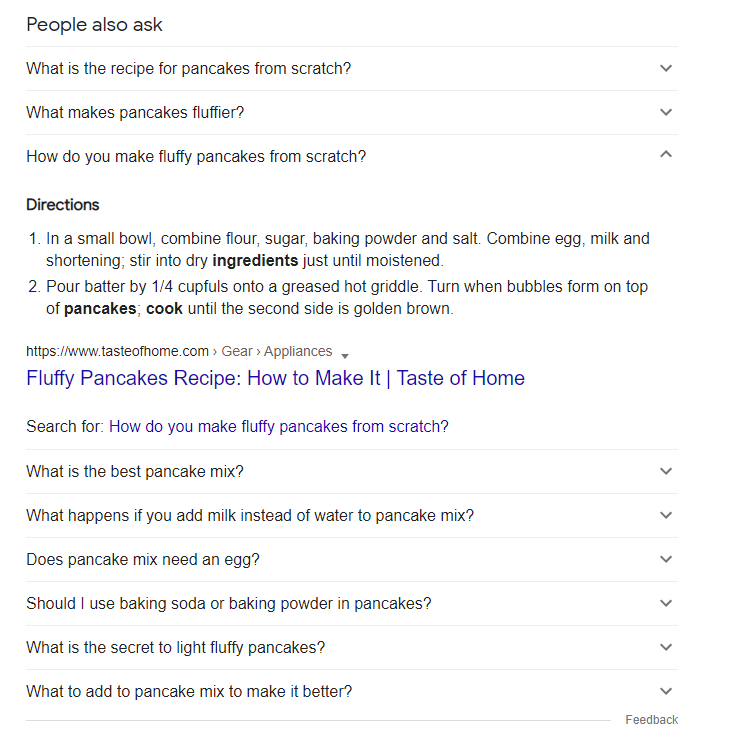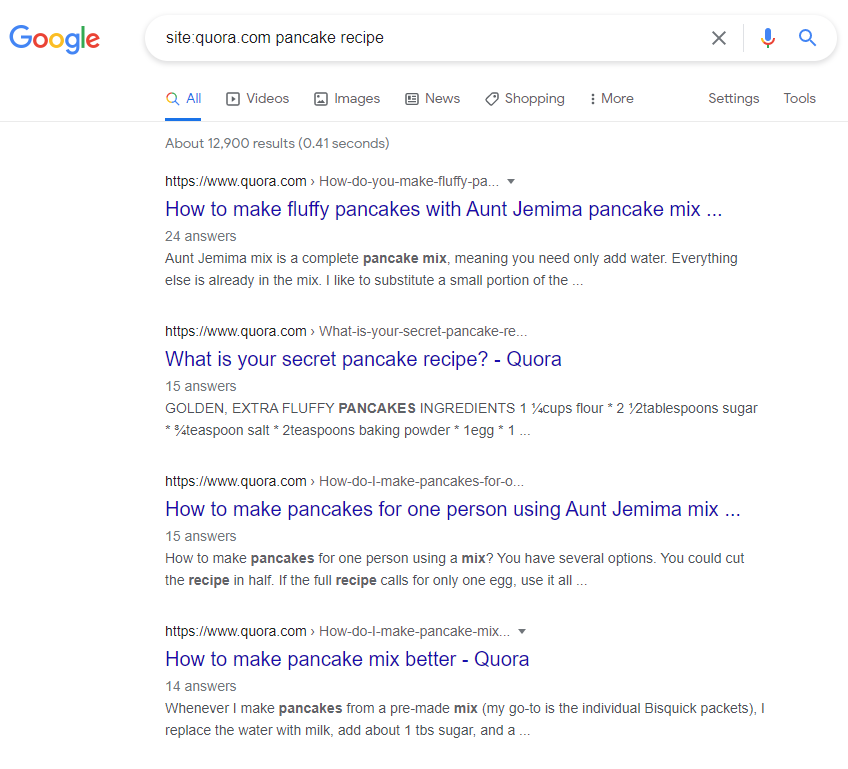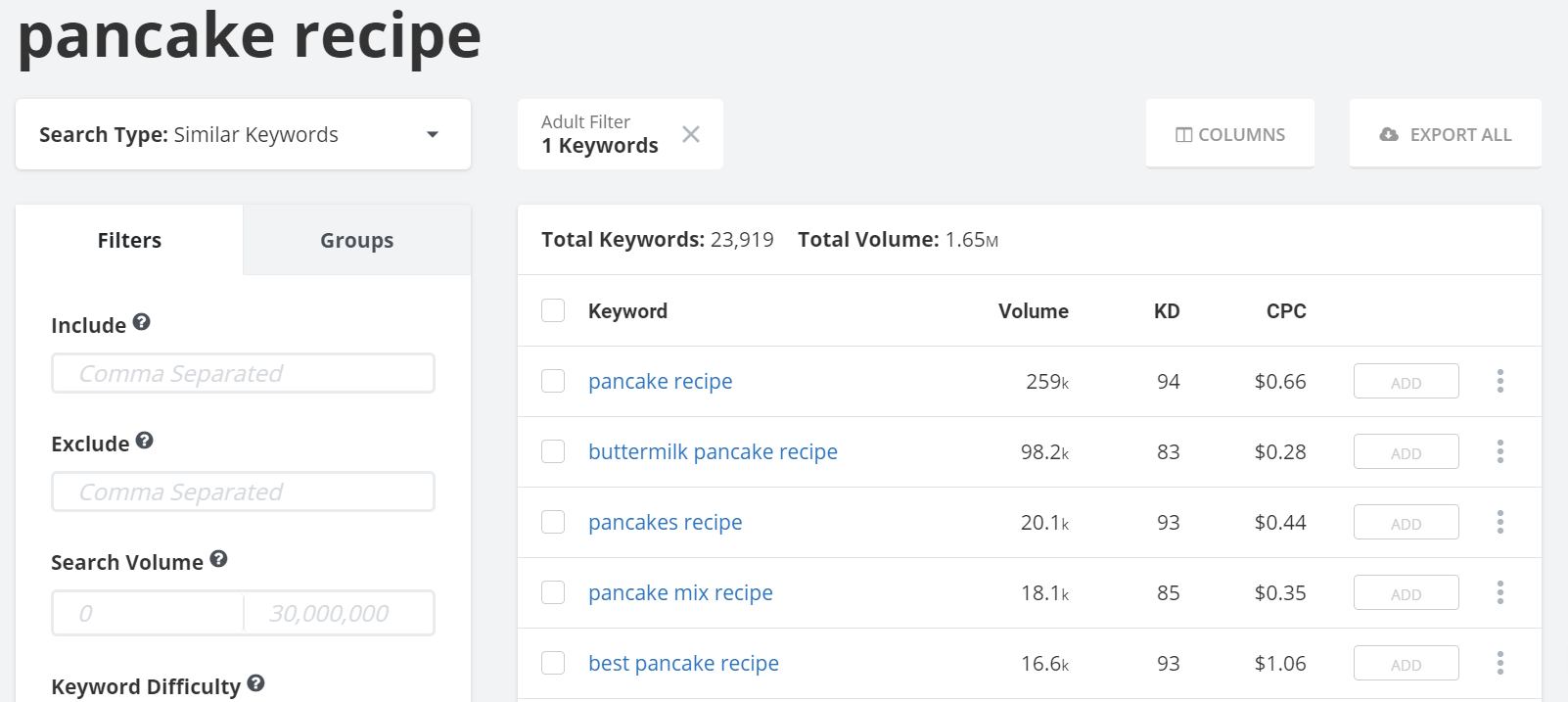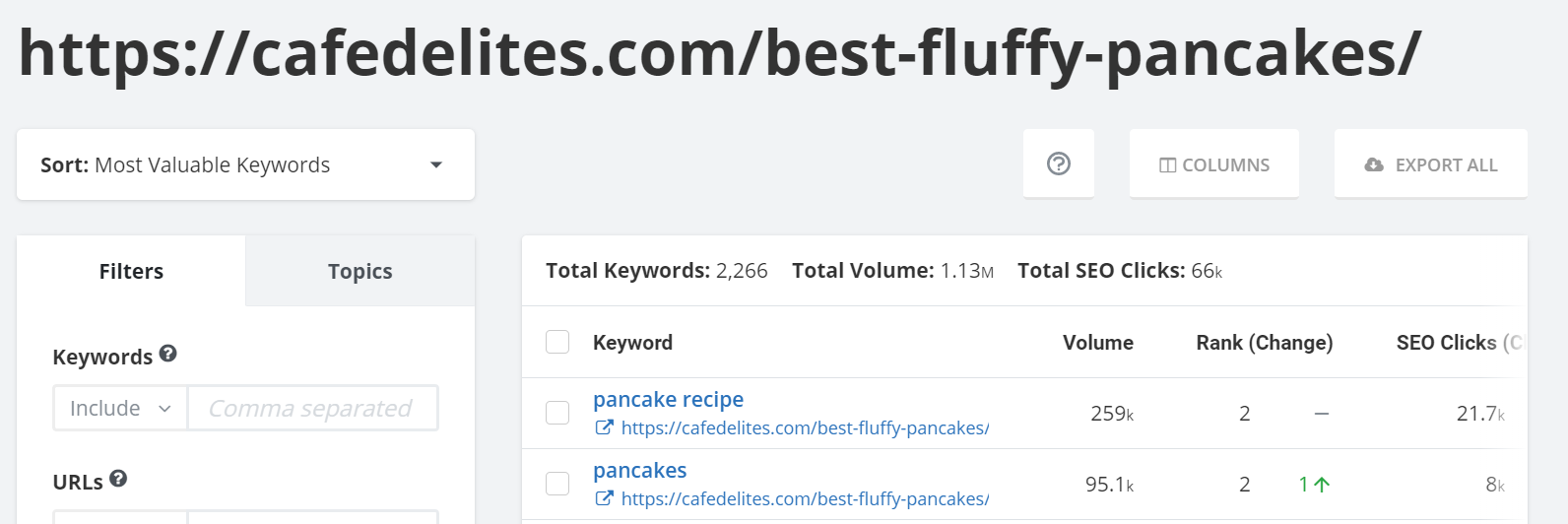You could optimize for a high-traffic short tail keyword like “best pancake recipes” and hope someone finds your page on a crowded and competitive search engine results page (SERP). Or you could create a hyper-targeted page aimed at the 80 people each month who search for the specific long tail keyword “the best gluten free blueberry pancake recipe.” But what if there was a third option?
Most people think they need to choose between traffic quantity and traffic quality. But when you optimize a page well, you can have your pancakes and eat them, too. You can rank for multiple long-tail keywords that bring relevant visitors to your site—and show Google you’re an authority on the topic, making it easier to rank for that short-tail keyword anyway.
Long-tail keywords, while having lower search volume than short or 'head' keywords, offer significant value if you know how to leverage them. They create better lines of communication between your business and customers already looking for what you provide.
Think about it: if you Google the word "sofa" (a very broad keyword sometimes referred to as a 'head term'), what are the chances you’re going to end up clicking through to a sale? But if you Google "elm wood veneer day-bed," you know exactly what you’re looking for and you’re probably prepared to pay for it then and there.
Obviously, you’re going to draw less traffic with a long-tail keyword than you would with a more common one, but the traffic you do draw will be better: more focused, more committed, and more desirous of your services. This specificity not only helps in conversions but also shows search engines that your site is a valuable resource for niche topics.
By strategically targeting both types of keywords, you can balance drawing in large volumes of general traffic while also capturing highly targeted visitors ready to convert, ultimately improving your site's overall performance.
What are Long Tail Keywords?
Long tail keywords are longer, more specific phrases that searchers use to find exactly what they’re looking for online. As you create more detailed, focused content you can do a better job of answering their question and connecting with a customer.
Why Are They Important for SEO?
Long tail terms pull a lot of weight. They have lower search volumes when compared to their shorter variations, but they do a better job getting targeted traffic to a page.
With shorter keywords, competition for rankings can be fierce, but visits can be scattershot, and ROI can be low. On the other hand, smart implementation of long-tail keywords may pull in less traffic, going purely by numbers, but the return on your investment will be proportionally much higher. You’ll be attracting exactly the audience you’re looking for, and that audience will be far closer to the point-of-purchase than that of your less-savvy competitors.
In paid search marketing campaigns, long-tailed keywords can also improve your bottom line by qualifying the visitor before they click. That works toward an improved conversion rate, setting off a domino effect of a better Quality Score and lower cost per click.
But why are these keywords so valuable for businesses?
Lower Cost Per Click
When you bid on long-tail keywords, the cost per click is inevitably lower since there’s less competition. This cost efficiency is a significant advantage, especially for businesses with limited advertising budgets.
Higher Ad Rankings
By targeting longer, more specific long-tail keywords in your campaigns, you can achieve higher ad rankings on relevant searches without having to pay a premium for every click. This can give you a competitive edge without breaking the bank.
The Challenge of Finding Long-Tail Keywords
The trick is to find a reliable, renewable source of long-tail keywords that are right for you and your niche. Many keyword suggestion tools often neglect this rich category, focusing only on the head terms. This leaves a gap that savvy marketers can exploit.
How to Find Long Tail Keyword Ideas
In this guide, we’ll show you how to take a single primary keyword and create an outline for dozens more related keywords. Those will bring in the searchers you want to appeal to. That means you’ll need to already have a primary keyword in mind. If you don’t, check out our guide to keyword research, and then come right back, so we can show you how to:
- Find long tail keyword ideas for a particular article.
- Identify long tail keywords with potential.
- Use those keywords to rank for as many other keywords as possible.
Not only will you increase your traffic numbers, but that traffic will be more relevant because of the specific search intent of long tail keywords.
Your first goal is to create a list of 20-30 keyword ideas—starting from the primary keyword you’ve already chosen. To create your list, go through our favorite places to find long tail keyword ideas, plug in your primary keyword, and write down what you find.
As you add keyword ideas to your list, filter out anything that isn’t relevant to your content goals or your audience. You don’t need to be too stringent, though; we’ll be narrowing down this list in the next section.
1. The Google SERP
The Google SERP is the most direct way to find relevant long tail keywords ideas. You’ll probably only get 10 or 15 keywords here, so pair this method with another on this list. Your focus should be on three areas in the SERP:
- The Autocomplete feature
- The People also ask section
- The Related searches section
Start by entering your primary keyword into Google’s search bar and write down the autocomplete suggestions it gives you.

Cut anything that isn’t relevant to your page and the general search intent you want to satisfy. For instance, the long tail “pancake recipe allrecipes” is clearly looking to navigate to allrecipes.com, so no need to include that in your own list.
Next, head to the SERP for your keyword and look at the “People also ask” section.

To get even more long tail keywords from “People also ask,” click on a question, and Google will add in a couple more questions at the bottom of the widget.
Last, scroll to the bottom of the page and look at the “Related searches” section.

Add these searches to your long tail keyword list. There may be overlap between these three sources on the SERP, so leave off any duplicates.
2. Answer the Public
Answer the Public is a free tool that shows you the questions that people are asking about your primary keyword. This tool is perfect for FAQ-style articles; you can easily find multiple headers that address the questions people have about your topic.
Head to answerthepublic.com, and after you enter your keyword, click on “Data” to get a more easily readable document.

Don’t be afraid to include keywords that aren’t grammatically correct. You won’t use them exactly as written, but they’re still useful for generating ideas.
3. Quora
Unlike Answer the Public, where questions are based on an algorithm, Quora allows you to tap directly into these questions and get a better idea of what searchers are thinking. Quora’s search bar will give you a list of results related to your primary keyword. Focus your search by selecting “Questions” on the sidebar and picking out relevant ones.

Quora’s search function is not always helpful. If you’re having trouble finding content that looks relevant, use Google search instead with the search operator “site:quora.com” and your keyword.

With Quora listings, don’t just write down the title. Explore the answers, too. They can help you determine what searchers want, which will help when you’re writing.
4. Google Search Console
Google Search Console (GSC) is the perfect place to find long tail keywords when refreshing an older piece of content. With GSC data, you can search by page and find long tail keywords that your content is already ranking for. You can then optimize for these keywords instead of trying to rank for something entirely new.
Log in to your GSC account, and then click on “Search results” on the left side of the screen. Next, click on “+ New” at the top of the screen and select “Page” from the dropdown menu.

Input the URL of the page you’re refreshing, and you’ll be given a list of queries (or keywords) that it’s already ranked for.

Take relevant long tail keywords from this list. Focus on keywords with high impressions (number of times you’ve appeared in someone’s search) and low clicks (number of times someone has clicked your page from a SERP). If a keyword has high impressions and low clicks, it means it’s ranking, but it isn’t getting clicked on—possibly because it doesn't fit people’s search intent. You can improve this when you reoptimize your page.
5. Keyword Research Tools
SpyFu's keyword research tools can give you keyword suggestions based on your primary keyword, so you can easily find long tail variations.
Head to the Related Keywords Tool and put in your primary keyword.

After taking what you can from the list, use SpyFu's Competitor Research Tool to see what keywords your competitors' pages are ranking for. You can target some of their relevant keywords yourself.
Go to our SEO Keywords Tool, type in the URL of a competing website on the SERP, and then see what keywords they rank for.

At this point, your long tail keyword research should be done. You now have a full list of at least 20-30 keyword ideas that you’ll use to target specific search intents alongside your more general primary keyword. Next, we’ll cut this list down to a manageable number of long tail keywords you can focus on in our final step.
How to Tell Which Long Tail Keywords You Should Optimize For
When narrowing your list of keyword ideas, consider three factors: basic keyword metrics, search intent, and their role in your content strategy.
Consider Basic Metrics
When we research a keyword’s basic metrics, we want to know how much interest there is in this keyword and how competitive it is. The two metrics we will look at are:
- Volume: How many people search for a keyword on average every month.
- Keyword Difficulty (KD): How competitive a keyword’s SERP is.
We can find both of these metrics using SpyFu’s Keyword Research Tool. Input the keyword and write down its volume and KD.
Ideally, you want low KD keywords. If you have a new website with relatively low traffic, a keyword with a high KD (90+) may be tough to rank for, and it would be better to prioritize a lower KD alternative for now.
You also want your keywords to have a high traffic volume. That being said, even relatively low traffic volumes can be helpful if they’re highly relevant. Twenty highly relevant searchers a month could be worth far more than 200 searchers who bounce because your content isn’t relevant to them.
Now that we've got a basic understanding of how competitive and valuable each keyword is, we need to know what searchers actually want when they look up each search term. Then we can decide if they're really relevant to our article, or if they don't belong.
Understanding the 80/20 Rule in Long-Tail Keywords
The 80/20 rule, also known as the Pareto Principle, can be fascinatingly applied to long-tail keywords. According to this principle, roughly 80% of consequences come from 20% of causes. In the realm of keyword searches, this means the majority of web traffic stems from a minority of the most commonly searched terms.
Breaking Down Keyword Popularity
While a handful of popular keywords generate massive search volumes, they only account for about 10-15% of total searches. These include highly searched keywords like "news" or "weather," which capture a large audience but represent just a slice of the bigger picture.
The Long-Tail Effect
Interestingly, approximately 70% of web traffic originates from long-tail keywords. These are more specific, less commonly searched phrases. For instance, instead of searching for "shoes," users might search for "best running shoes for flat feet."
Applying the 80/20 Rule
By focusing on long-tail keywords:
- Targeted Traffic: You attract highly specific user intents.
- Lower Competition: Fewer sites optimize for these phrases, making it easier to rank higher.
- Conversion Rates: Users searching long-tail keywords often look for something specific, increasing the chances of conversion.
In essence, although long-tail keywords individually contribute less search volume, collectively they drive 80% of relevant and high-converting traffic, embodying the essence of the 80/20 rule in a digital marketing context.
Understand Search Intent
Search intent is the single most important factor you need to consider when identifying which keywords to optimize for. You need to understand what different searchers will want to find when they search the keywords you’re targeting.
To understand the search intent behind your primary keyword, follow our guide to search intent analysis.
The point of understanding search intent is to get a clear picture of who your searchers are, what kind of content they are looking for, and which topics they want explained. To do this, you need to:
- Understand the general intent behind the keyword (buy something, learn about something, etc.).
- Look at the SERP and see what kind of content Google believes satisfies search intent the best (listicles, Q&A posts, videos, testimonials, reviews, etc.).
- Explore the top pages on the SERP and see what topics they talk about. Pay attention to the H2s and H3s.
- Use social media and question sites like Quora to see what people are saying or asking about this topic.
- Consider what your existing audience would want from this kind of content.
For example, if you’re creating a post on how to make pancakes, you could look through the above resources and come to the conclusion that people want:
- Easy recipes
- Breakfast pancakes and not savory dinner pancakes
- To know how to make pancakes from scratch
- To know how to sub basic ingredients like milk or eggs
Knowing this, you could remove long tail keywords like “how to make potato pancakes” or “how to make scallion pancakes,” as both are savory options. You could also remove “how to make pancakes from a mix.”
Use this to start cutting down your keyword list. If the keyword isn’t relevant to your audience, then cut it. You should now be left with only relevant keywords. Our next step is to cut your list of relevant keywords down to only the keywords that will work in this specific piece of content.
Determine What Role each keyword Could Play In Your Content
You now need to identify the long tail keywords you want to optimize your article for alongside your original primary keyword. To find these keywords, you need to know whether they are primary or secondary keywords and how they can fit in your future article.
To figure out the role each of your keywords could play in your future content, you first need to determine whether that keyword is best suited to being a primary or a secondary keyword. A primary keyword is the most important keyword on the page; it is usually the larger umbrella topic that your secondary keywords will fall under. A secondary keyword adds nuance and specificity to your primary keyword; secondary keywords cannot or should not be their own article because there is not enough material, interest, or use for it being its own post, so it is better suited to support a primary keyword.
For instance, “how to mix pancake batter” would be hard to spin into its own article, and few people only want to know about this one topic apart from the larger question of “how to make pancakes.” For this reason, “how to mix pancake batter” is better suited to being a secondary keyword embedded inside an article about making pancakes.
Chances are, during your keyword research, you stumbled upon some long tail keywords that would make great primary keywords. At this point, you can choose to swap out your current primary keyword for one of these new primary keywords if they have better search metrics and match the search intent you want to satisfy. Or you could remove them from your current long tail keyword list and put them on your content calendar as future projects.
Either way, you need to know how to determine if a keyword should be a primary or a secondary keyword. The best way to determine this is to check its SERP. If all of the top pages are for a broader topic, you probably have a secondary keyword. For instance, this SERP for “how to mix pancake batter” shows you pages about pancake recipes and how to make pancakes.

On the other hand, if you see a SERP with pages that match your keyword, you probably have a primary keyword.

We have two more things to look at before we finalize our keyword list. The first is keyword cannibalization: when you have more than one page competing for the same keyword. When this happens, it can hurt your pages’ ranking chances. Remove any long tail keywords that you’ve already addressed in other articles.
Last, you’ll form an idea of which subtopics you’ll prioritize in your writing. You can’t address everyone’s questions—you’ll end up writing a long, wandering post that serves no one. So you need to choose a few.
Look at your keyword list and start to plan out which ones could fit together to make a cohesive article. For example, our long tail keyword list could look like this:
- How to make fluffy pancakes
- How to make pancakes from scratch
- How to make pancakes with one egg
- How to make pancakes without baking powder
- How to make blueberry pancakes
- How to make banana pancakes
- How to make pancake mix
- How to make chocolate pancakes
- How to make pancake syrup
- Gluten free pancake recipe
- Pancake recipe no milk
- Paleo pancake recipe
From this list, we could decide to write an article that looks at “how to make pancakes from scratch.” It could include sections on popular pancake variations like blueberry, banana, and chocolate. If we have room, we could also include a helpful section that would tell cooks how to sub ingredients if they need to. Anything that doesn't fit these parameters could be removed. Our list should now look like this:
- How to make fluffy pancakes
- How to make pancakes from scratch
- How to make pancakes with one egg
- How to make pancakes without baking powder
- How to make blueberry pancakes
- How to make banana pancakes
How to make pancake mix- How to make chocolate pancakes
How to make pancake syrup- Gluten free pancake recipe
- Pancake recipe no milk
- Paleo pancake recipe
With your long tail keyword list finalized, it’s time to learn how to use them properly to increase your chances of ranking.
How to Use Long Tail Keywords for On-Page SEO
In general, the effective use of long tail keywords in on-page SEO boils down to the following two main principles: add your keywords where you can and only if it contributes to user experience.
To see how this works, let’s look at an example. For our pancake article, we have settled on the primary keyword of “How to make pancakes from scratch” because it has a volume of 18,800, and it acts as a nice umbrella term for a lot of other subtopics. Our remaining long tail keywords now need to be slotted in as either headers or in the body:
H1: How to Make Pancakes from Scratch with 4 Awesome Variations
H2: How to Make Basic Pancakes from Scratch
- Body: How to Make Fluffy Pancakes
H2: Variation 1: How to Make Blueberry Pancakes
H2: Variation 2: How to Make Banana Pancakes
H2: Variation 3: How to Make Chocolate Pancakes
H2: Adjusting the RecipeH3: How to Make Pancakes Without Milk
H3: How to Make Gluten Free Pancakes
H3: How to Make Paleo Pancakes
H2: More Awesome Breakfast Recipes
We’ve slotted the majority of our long tail keywords into our headers. One of our long tail keywords didn’t fit into the header (how to make fluffy pancakes), so we included it as a note to try to include it in the body of the first section. Also, a couple of our keywords (“pancakes no milk” and “paleo pancake recipe”) didn’t quite match the “how to...” header style we had, so we adjusted them to fit. Google is getting very good at understanding natural language, so we don’t necessarily need to get the exact keyword in as long as we have the idea represented.
Finally, some long tail keywords didn’t make it into our article because we lacked room; we didn’t want our article to get too long, so we cut where we had to.
With our outline made, we can start writing. Pepper in keywords where you can, but always keep it natural. Here are some tips:
- Add keywords to image titles, alt-texts, and anchor text where appropriate.
- Don’t worry about keyword density; it doesn’t matter in modern SEO.
- Try to add your most important long tail keyword into your title and meta-description if it doesn’t hurt readability.
There’s so much more you can do to optimize your on-page SEO. To learn more, check out our on-page optimizations checklist.
With on-page dealt with, it's now time to consider how to optimize at the site level. To do this, we will introduce two potential strategies you can use to boost your organic traffic.
How to Optimize at the Site Level
By thinking ahead and knowing how to use your long tail keywords at the site level, you can improve your domain strength and topical authority. This is also a chance to use some of the primary keywords that you found and set aside in the research process. By creating multiple articles all focused on a central theme, you can help each page have a better chance to rank.
The Hub and Spoke Model
This SEO content strategy uses long tail keywords to bolster your ranking potential for a short tail keyword. By creating spokes that target long tail keywords, all linking to a hub article targeting a short tail keyword, you build a structure that’s more appealing to search engines and easier to browse by website visitors.
The hub and spoke model is best used when you have a competitive, complicated central idea that requires multiple articles to explain the intricacies of the subtopics that make up the central idea. For instance, “breakfast ideas” is too broad to be handled in one article, so instead, it could become the hub for multiple spokes that deal with different categories of breakfast foods.

This is a valuable strategy for building domain strength, as well. Each spoke links to the hub and transfers some of its link equity, which is returned when the hub links out to each spoke. This internal linking strategy helps search engines understand how your content builds on itself, boosting your topical authority while at the same time making it easier for visitors to go deeper into your site.
The Keyword Batch Strategy
This strategy takes a bit of a different angle on how to target long tail keywords. Instead of focusing on a hub article that goes after a more high-volume, competitive short tail keyword, you’re using the compounding effects of long tail keywords to build strength with every new article.
The goal here is to create a batch of long tail keywords and go after them systematically, from lowest volume or difficulty to highest. In doing so, you’re not only making it easier on yourself to rank faster; each new article that you write builds on the strength of those before it through internal linking. This also increases your domain authority incrementally, signaling to search engines that you’re creating a comprehensive resource on the topic.
The keyword batch strategy is somewhat more straightforward than the hub and spoke model and requires a little bit less work to accomplish. You also don’t need a high-level short tail keyword to build the hub around, so the topics you’ll be writing about are, while still connected, not tied to a single target.
Stay Current on Additional Factors
SEO is always changing, and if you want to keep up, you need to know what is working right now to get your work on Google. Long tail keywords are just one important piece of the SEO puzzle that you need to be up to date on. To make sure your SEO tactics are still current, we’ve created an SEO audit that will keep your website at the top of the SERP. You should also check out our article on the Google Page Experience update that addresses jumping items on the page, long load times (not as long as you think), and large images. These are handled through technical adjustments, but to users they are obvious annoyances.

